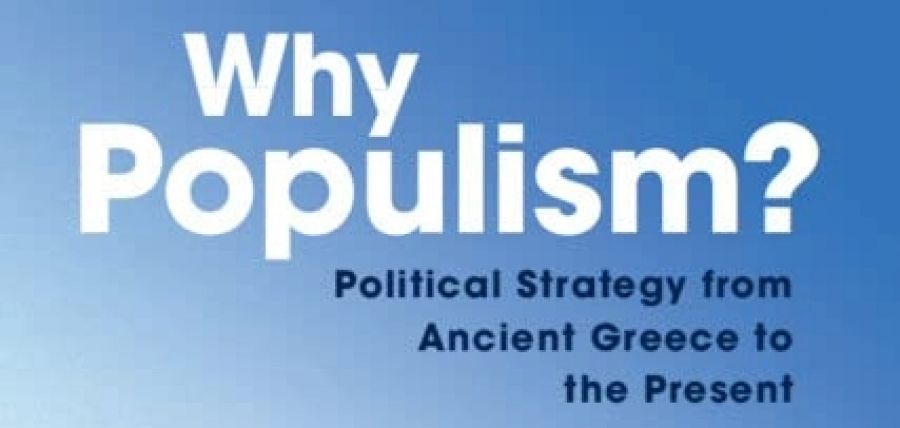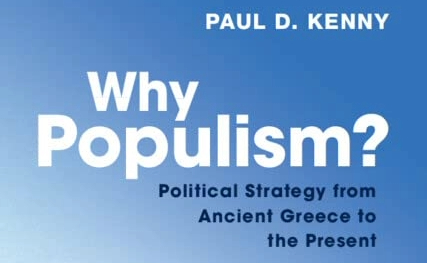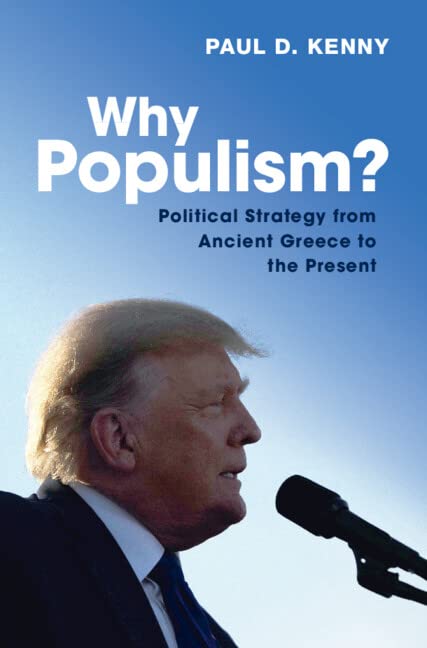
- Free Article: No
- Contents Category: Politics
- Review Article: Yes
- Article Title: Supply-side populism
- Article Subtitle: Explaining the success of populism
- Online Only: No
- Custom Highlight Text:
Paul D. Kenny’s impressive and engaging book is a corrective to the well-established body of work on populism. This corpus grew in tandem with the most recent successes of populism that have been a feature of contemporary liberal democracies in the past decade, and are a source of anxiety to many who care about democracy and value pluralism.
- Article Hero Image (920px wide):

- Article Hero Image Caption: Donald Trump and Victor Orban at the NATO Summit in 2017 ( Julien Mattia/ZUMA Wire/Alamy)
- Featured Image (400px * 250px):

- Alt Tag (Featured Image): Ben Wellings reviews 'Why Populism? Political strategy from Ancient Greece to the present' by Paul D. Kenny
- Book 1 Title: Why Populism?
- Book 1 Subtitle: Political strategy from Ancient Greece to the present
- Book 1 Biblio: Cambridge University Press, $56.95 hb, 282 pp
- Book 1 Cover Small (400 x 600):

- Book 1 Cover (800 x 1200):

Kenny’s engagement with this literature draws from the economic side of the debate about populism’s causes, perhaps overly so. Kenny has usefully moved beyond the question of what populism is (as in Cas Mudde’s populists, who are tribunes against a corrupt élite, or Jan-Werner Müller populists, who are anti-pluralistic and hence anti-democratic actors), and focuses instead on the question of why populism appears effective at certain moments in history.
Kenny’s engagement owes much to analysis associated with classical economics. Kenny is concerned less with ‘demand-driven’ explanations that stress the resentment of the electorate and the responses of political entrepreneurs, and more with ‘supply-side’ explanations. He focuses on why – ceteris paribus – politicians might choose to be populists. This takes us beyond a sense that populist politicians are motivated by their espoused beliefs. Instead, Kenny asks readers to consider a more mundane explanation: at certain times and in certain places, populism may simply be more cost effective than any other type of politics.
Kenny suggests that there are two alternatives to populism: patronage and parties. Both of these approaches involve costs that populists don’t have to bear. Political parties are a massive drain on time and energy, acting as a drag on the political aspirations of their leaders. Patronage is literally expensive, and at times requires the doling out of treasure as well as careful relationship management to keep the system working in the leader’s favour.
In contrast, populists have fewer such cares. They tend to eschew parties and initially prefer ‘movements’ that seemingly express the ‘will of the People’ – or the populists’ interpretation of it. This approach offers less accountability and hence acts as less of a brake on leaders’ ambitions.
But it’s not all rainbows and unicorns for populists and their efficient, cost-saving political strategies. Kenny reminds us that populists aren’t necessarily popular. (France, where both Emmanuel Macron’s and Marine Le Pen’s movement-parties fit Kenny’s definition of populism, is an exception.) One of the main causes of populists’ disdain for democratic norms and institutions is that once they have been admitted to positions of power in government – usually, but not exclusively, by centre-right governments worried about losing votes – they are acutely aware that they are unlikely to win power again by democratic means. Hence their main aims are to capture institutions valuable to democracy – free media, legal and educational systems, cultural institutions, even other parties – and bend them to their world view, further closing down sources of ideational opposition. This mid-term approach to establishing political hegemony has been effective in Hungary and Poland, for example.
But this insight suggests that it isn’t all about the iron laws of economics. In this account of populism, ideas and ideologies play only a supporting role. Phenomena such as nationalism, xenophobia, and racism often feature as symptoms that opponents of populism decry, yet it would be a mistake to minimise the significance of these phenomena. A thought experiment might help here: would it be possible to understand the appeal and motivations of Narendra Modi, Donald Trump, or Viktor Orbán without an understanding of the ideas and issues animating nationalist politics in India, the United States, or Hungary, respectively?
Kenny’s main argument about supply-side drivers is useful, but is slightly overstated. Analyses of populism should not overlook the specificities in each case. These specificities are crucial to any explanation of why populist claims resonate with enough voters to make the populist critique central to contemporary politics in liberal, and increasingly illiberal, democracies. An over-emphasis on the rational cost-benefit analysis of each of the politicians named above would provide an impoverished account of their appeal, and possibly their motivations too. To do so, we would have to assume that identity politics do not really matter to Modi, Trump, and Orbán, and play no part in their governing strategies.
Kenny’s comparative analysis over time as well as space is welcome. In some ways this is a source of solace – populism comes and goes. But here again there is a tendency to rely too heavily on the mechanics of economic analysis: ‘What this historical perspective shows is that the economic laws of populism are constant; when conditions that affect the cost of different types of political strategy change, so too does the effectiveness of populism.’
Admittedly, Kenny’s aim is to address the neglected understanding of the supply-side drivers of populism, which his analysis does well. We’ll have to wait for what he calls the ‘general equilibrium theory’ that marries the supply and demand sides in a single analysis. This is necessary because one of the things that surprised experts when the United Kingdom voted to leave the European Union, and Trump won the US presidency, was that many voters were not behaving as ‘rational actors’ and were notionally voting against their economic (but maybe not their social) interests.
The conclusions stemming from Kenny’s analysis may be small comfort for those troubled by populism. It may be encouraging to know that populist leaders might not believe all the things they say in public. But the fact that Kenny shows it is all about leaders and their search for power is slim consolation. Normatively, Kenny asks us to rethink and reinvigorate political parties to keep the threat posed by populism to liberal democracy in check. Often maligned and mistrusted, parties perform the dull but important procedural stuff that is essential for keeping the egotistical and self-serving impulses of leaders in check, a role that Republicans in the United States are currently failing to play.
‘Ask a poet and a neuroscientist to define love,’ Kenny rightly points out, ‘and you’ll get two equally true but very different answers.’ Likewise, there is a sense that in this account Kenny has explained part of the phenomenon of populism without truly accounting for its spell. This is an engagingly written account, even if there are some obvious typographical errors around historical dates that need correcting. Nevertheless, this book is an important addition to what we know about populism and populist politics.


Comments powered by CComment